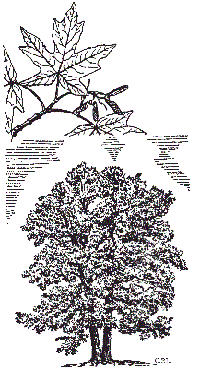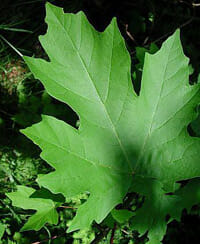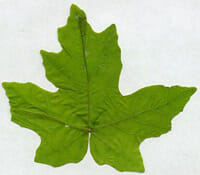Broadleaf Maple – Sapindales Aceraceae Acer macrophyllum
 |
 |
 |
Identification & Description:
Native bushy-headed tree, variable in habit. Leaves are five-lobed dark green, turning a striking clear yellow in autumn.
Good on chalk given a deep topsoil and very heavy soils. Lovely tree for natural or rural planting, but use Acer campestre ‘Streetwise’ when a more consistent form is required for street or car park planting.
Physical Characteristics
A decidious tree growing to 5m at a medium rate. It is hardy to zone 6. It is in flower in May, and the seeds ripen from July to August. The scented flowers are hermaphrodite (have both male and female organs) and are pollinated by Insects. We rate it 2 out of 5 for usefulness.
The plant prefers light (sandy), medium (loamy) and heavy (clay) soils and requires well-drained soil. The plant prefers acid, neutral and basic (alkaline) soils. It can grow in semi-shade (light woodland) or no shade. It requires moist soil.
Unique Features:
• Largest and fastest growing maple in Canada
• Narrow crown supported by a branch-free stem for half its length when grown in the forest
• When grown in the open, a few large, spreading branches support a broad crown
• Seeds are food for small mammals and birds
• Twigs are food for elk and deer
• Often draped in mosses
Edible Uses
Fruit; Seed.
Fruit – raw or cooked. Intensely bitter. Some native North American Indian tribes saw the fruit as a great delicacy and an important food source, though others only ate it occasionally because of its bitter taste. The fruit is 8 – 15mm in diameter with a thick flesh, and contains one large seed.
Seed – raw or cooked. Do not eat the seed if it is too bitter – see the notes above on toxicity.
Other Uses
• Modern – furniture, interior finishing, musical instruments, flowers can be used in salads
• Traditional – wood: dishes, pipes, clothing hooks, paddles; inner bark: baskets, rope and whisks; young shoots: eaten; sap: type of maple syrup
Basketry; Dye; Fuel; String; Wood.
A green dye can be obtained from the leaves.
A dark grey to green dye can be obtained from the fruit.
The bark is used to ornament baskets and is also split into strips and used for making baskets that are watertight and resist decay. The bark is both strong and flexible as well as being ornamental. The thin outer bark can be peeled off the tree in the same way as birch trees. It has been used to make baskets, mats, ropes and as an ornament on bows, arrows etc. The bark can also be made into a string.
Wood – close-grained, soft, brittle. It is sometimes used for furniture because it takes a high polish. An excellent fuel.
Cultivation details
Thrives in a well-drained moisture-retentive loamy soil. Prefers some lime in the soil but is likely to become chlorotic if too much lime is present. Succeeds in sun or partial shade though it fruits better in a sunny position. This species is unable to tolerate much shade competition from other trees.
A fast-growing but short-lived species in the wild.
The flowers diffuse a soft honey scent.
Most members of this genus are shallow-rooted and will produce suckers if the roots are damaged.
Plants in this genus are notably susceptible to honey fungus.
Propagation
Seed – requires 2 – 3 months cold stratification and is best sown in a cold frame as soon as it is ripe. Sow stored seed in a cold frame as early in the year as possible. Protect the seed from mice etc. The seed can be rather slow, sometimes taking 18 months to germinate. Prick out the seedlings into individual pots when they are large enough to handle. Grow them on in a greenhouse or cold frame for their first winter and plant them out in late spring or early summer of the following year.
Cuttings of half-ripe wood with a heel, July/August in a frame.
Softwood cuttings from strongly growing plants in spring to early summer in a frame.